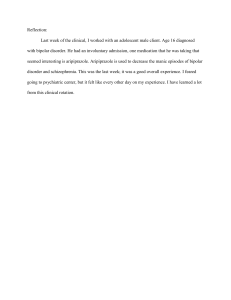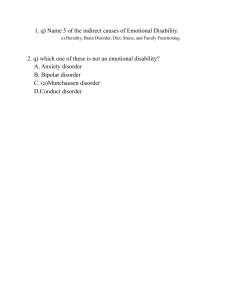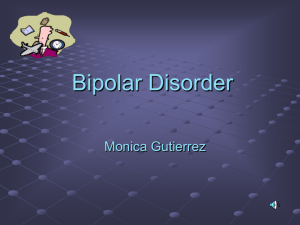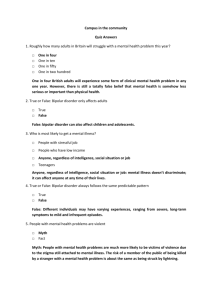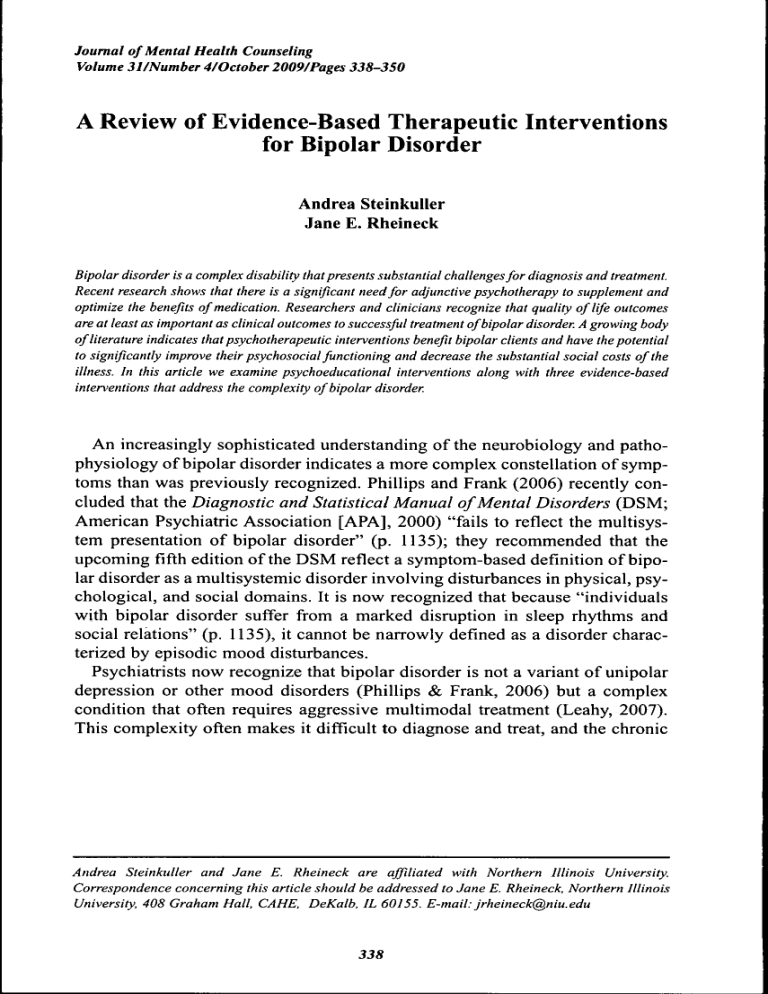
Journal of Mental Health Counseling Volume 31/Number 4/October 2009/Pages 338-350 A Review oí Evidence-Based Therapeutic Interventions for Bipolar Disorder Andrea Steinkuller Jane E. Rheineck Bipolar disorder is a complex disability that presents substantial challenges for diagnosis and treatment. Recent research shows that there is a significant need for adjunctive psychotherapy to supplement and optimize the benefits of medication. Researchers and clinicians recognize that quality of life outcomes are at ¡east as important as clinical outcomes to successful treatment of bipolar disorder A growing body of literature indicates that psychotherapeutic interventions benefit bipolar clients and have the potential to significantly improve their psychosocial functioning and decrease the substantial social costs of the illness. In this article we examine psychoeducational interventions along with three evidence-based interventions that address the complexity of bipolar disorder An increasingly sophisticated understanding of the neurobiology and pathophysiology of bipolar disorder indicates a more complex constellation of symptoms than was previously recognized. Phillips and Frank (2006) recently concluded that the Diagnostic and Statistical Manual of Mental Disorders (DSM; American Psychiatric Association [APA], 2000) "fails to refiect the multisystem presentation of bipolar disorder" (p. 1135); they recommended that the upcoming fifth edition of the DSM reflect a symptom-based definition of bipolar disorder as a multisystemic disorder involving disturbances in physical, psychological, and social domains. It is now recognized that because "individuals with bipolar disorder suffer from a marked disruption in sleep rhythms and social relations" (p. 1135), it cannot be narrowly defined as a disorder characterized by episodic mood disturbances. Psychiatrists now recognize that bipolar disorder is not a variant of unipolar depression or other mood disorders (Phillips & Frank, 2006) but a complex condition that often requires aggressive multimodal treatment (Leahy, 2007). This complexity often makes it difficult to diagnose and treat, and the chronic Andrea Steinkuller and Jane E. Rheineck are affiliated with Northern Illinois University. Correspondence concerning this article should be addressed to Jane E. Rheineck, Northern Illinois University, 408 Graham Hall, CAHE, DeKalb, IL 60155. E-mail: jrheineck@niu.edu 338 Steinkutter and Rheineck I EVIDENCE-BASED THERAPEUTIC INTERVENTIONS 339 symptomology and impairment experienced by individuals with the disorder signiflcantly impacts their physical health and overall quality of life (Culver, Amow, & Ketter, 2007). The following review of four evidence-based practices (psychoeducation, cognitive behavioral therapy, family-focused therapy, and interpersonal and social rhythm therapy) provides an overview of the nature of bipolar disorder and the diagnostic and treatment challenges it presents. The primary intent is to highlight the need for adjunct psychotherapy to enhance pharmacological treatments for individuals with bipolar disorder. BIPOLAR DISORDER: A BIGGER PICTURE The DSM estimates the lifetime prevalence of bipolar I disorders (recurrent episodes of depression and mania) as 0.4-1.6% and bipolar II disorders (milder mania that alternates with depressive moods) as 0.4-0.5% (APA, 2000; Merikangas et al., 2007). It is the sixth most common cause of disability in the United States, the flfth leading cause of disability among 15-44-year-olds globally, and the ninth leading cause of years lost due to death or disability worldwide (World Health Organization [WHO], 2001). The lifetime rate for completed suicide among people with bipolar disorder has been estimated to be 60 times higher than that for the general population (Baldessarini, Pompili, & Tondo, 2006). Woods (2000) estimated the societal cost of bipolar disorder at $45 billion annually in the United States alone. These statistics highlight the signiflcance of bipolar disorder as a public health concern. A Complex Disability The DSM alone cannot convey the devastating effects that bipolar disorder has on a patient's quality of life. The conventional view that bipolar disorder has a better prognosis than schizophrenia has been challenged due to the large percentage of patients who exhibit chronic residual affective symptoms and unpredictable mood cycling and therefore experience signiflcant impairment in psychosocial functioning (Zaretsky, Rizvi, & Parikh, 2007). Murray and Michalak (2007) stated that "if bipolar disorder develops in a woman at the age of 25, she may lose 9 years in life expectancy (due to medical problems), 14 years of productivity, and 12 years of good health" (p. 24). As a consequence of their illness, the quality of life for individuals with bipolar disorder is characterized by lower wages, higher unemployment, work absenteeism and disability, marked interpersonal relationship instability and higher divorce rates, lower levels of educational attainment, and higher rates of arrest, hospitalization, and premature death compared to the general population (Depp, Davis, Mittal, Patterson, & Jeste, 2006). 340 JOURNAL OF MENTAL HEALTH COUNSELING Bipolar Disorder Treatment Challenges Interpersonal problems, life events, and lack of stress-management skills are characteristic of bipolar disorder, and these Stressors worsen the course and outcomes of the illness (Basco, Ladd, Myers, & Tyler, 2007). Typically, pharmacological treatments are essential for managing bipolar disorder (Miklowitz & Ofto, 2006); however, medication alone is often inadequate to restore and maintain physical health and quality of life. For example, one study found that as many as 60% of patients never regain full occupational and social ftinctioning (MacQueen, Young, & Joffe, 2001). Research increasingly supports the theory that a combination of pharmacotherapy and psychotherapy significantly improves long-term outcomes for these individuals (Culver et al., 2007; Leahy, 2007; Miklowitz & Otto, 2006; Rizvi & Zaretsky, 2007); therefore, an integrated care approach to managing bipolar disorder gives therapists an opportunity to significantly improve ftinctioning and quality of life for clients and their families. The therapeutic objectives for managing bipolar disorder to maximize healthy ftinctioning include treatment of acute manic and depressive episodes, reducing the risk of suicide, relapse prevention (a lifelong risk), and symptom awareness and control (Culver, et al., 2007). Culver et al. stressed that counseling interventions should address these significant treatment challenges for the disorder in the life context of individual patients and their families. RATIONALE FOR THERAPEUTIC INTERVENTIONS According to Culver, Amow, and Ketter (2007), medications used to treat bipolar disorder have been inadequate for a large proportion of these patients, who report persisting depressive or manic symptoms after a year on medications. The primary treatment challenge is nonadherence to medication regimens: approximately 60% of bipolar clients take less than 30% of their medication as prescribed (Culver, Amow, and Ketter, 2007; Rizvi & Zaretsky, 2007). Since medication alone appears to be ineffective, therapeutic interventions for bipolar disorder, such as psychoeducation and other counseling modalities, have become increasingly evidenced-based and integrated into treatment. Rizvi and Zaretsky (2007), along with Miklowitz and Otto (2006), demonstrated that psychoeducation, cognitive behavioral therapy, family-focused therapy, and interpersonal and social rhythm therapy are effective adjunct treatments (in addition to medication). Murray and Michalak (2007) concurred that psychosocial interventions in conjunction with medications showed promise of improving both clinical and quality of life outcomes and family functioning. Clinical Outcomes The primary clinical goals of therapeutic interventions in patients with Steinkutter and Rheineck I EVIDENCE-BASED THERAPEUTIC INTERVENTIONS 341 bipolar disorder include psychoeducation about the nature and treatment ofthe disorder, symptom reduction, episode prevention, medication adherence, increased recognition of early symptomology, facilitation of early medical intervention, and strategies for relapse prevention (Culver, Amow, & Ketter, 2007). Culver, Amow, and Ketter also reported that therapeutic interventions can provide clients with the knowledge, skills, and tools to effectively manage their disorder. Psychotherapy, when used to supplement and support medication regimens, may allow patients to decrease or eliminate reliance on antidepressant medications, which are thought to increase the risk of mood destabilization and acute manic or mixed episodes (Zaretsky, Rizvi, & Parikh, 2007). The four interventions examined here have yielded positive results. Psychoeducation in conjunction with medication has been shown not only to increase the client's knowledge but also to delay relapse as well as reducing the number of relapses (Colom et al., 2003). Cognitive behavioral therapy with medication also yielded fewer relapses and improved adherence to medication and psychosocial functioning (Lam & Gale, 2000). Although family-focused therapy showed no benefit in reducing risk of relapse (Rea et al., 2003), it was found that clients had fewer relapses than those receiving just individual therapy. Interpersonal and social rhythm therapy showed limited but positive results; it was not shown to be superior to control treatments but showed evidence that suicidal risk decreased as well as the person's social rhythm (Frank et al., 2005; Rucci et al., 2002). Quality of Life Outcomes In addition to clinical outcomes, the quality of life of individuals with bipolar disorder is commanding increased attention. Some patients function poorly despite having relatively few symptoms; others fiinction well despite having relatively severe symptoms (Murray & Michalak, 2007). Similarly, there is dissonance between improvement in symptoms and improvement in quality of life measures in response to treatment, "with the latter lagging substantially behind the former" (p. 24). When patients assess the success of their treatment, they focus on more than clinical symptoms, and optimal treatment benefit will result when therapists adopt a holistic approach. Murray and Michalak predicted that "it may be in the area of functional outcomes that psychosocial interventions make their strongest contribution" (p. 24). The WHO describes quality of life as "the individual's perception of their position in life in the context of the culture and value systems in which they live, and in relation to their goals, expectations, standards, and concems" (Murray & Michalak, p. 24). There has been little quantitative research into quality of life for people with bipolar (versus unipolar) disorder, but one study found that quality of life among people with bipolar disorder was significantly compromised compared to the general population, particularly with regard to 342 JOURNAL OF MENTAL HEALTH COUNSELING (a) physical and social functioning, (b) physical and emotional role limitations, (c) vitality, and (d) mental and general health (Amold, Witzeman, Swank, McElroy, & Keck, 2000). An additional study showed that participants with bipolar disorder were significantly more impaired on these measures than those with other mood, anxiety, and substance use disorders (ten Have, Vollebergh, Bijl, & Nolen, 2002). A third study found that the depressive episodes and residual depressive symptoms characteristic of bipolar II were most strongly associated with poor emotional quality of life, even after controlling for potentially confounding variables, such as socioeconomic status and life Stressors (Zhang et al., 2006). Family Considerations Marsh (1999) stated that because serious mental illness has a powerful impact on families as well as individuals, there is a sound rationale for including families in treatment approaches. Family members often assume the role of caregivers, as they might with any chronic health problem, and as informal case managers and advocates they can play an important role in the family member's treatment, rehabilitation, and recovery. Marsh also reported that family attitudes and behaviors have been shown to affect the course of serious mental illness, including bipolar disorder. Thus, an educated and supportive family can be a significant asset for the patient and mental health professionals. Mental illness in a family can be an enormous Stressor, and the resulting trauma and exhaustion can leave other members at risk for stress-related physical and mental health problems (Lefiey, 1996). Subjective burdens experienced by the family can include grief, loss of hopes and expectations for the future, chronic sadness, and the turmoil of the emotional roller coaster of acute episodic illness cycles (Marsh, 1999). Marsh stated that families also deal with objective burdens, such as symptom-related behavior, care-giving responsibility, family disruption, ongoing stress, problems with healthcare delivery systems and insurance, financial problems, and the social stigma associated with mental illness. The dynamics of family systems can significantly affect how well families cope with a mentally ill member (Marsh, 1999). Family members are impacted to different degrees, and the impact may depend on their life phase and roles within the family system. Most of the research has focused on parents of people with mental illness, even though approximately 33% of patients go home to a spouse rather than a parent after hospitalization (Marsh). In addition to parents and spouses, siblings and children of the mentally ill client may be overwhelmed or unable to cope, experience alienation and guilt, or be forced to assume roles for which they are not developmentally ready. Family interventions for all members should be designed to target three essential family needs: "information about mental illness and its treatment, skills to cope Steinkuller and Rheineck I EVIDENCE-BASED THERAPEUTIC INTERVENTIONS 343 with the illness and its consequences, and support for themselves" (Marsh, p. 361). Understanding not only the idiosyncrasies but the family system of a client will provide insight into the most appropriate and effective evidencebased treatments. EVIDENCE-BASED PSYCHOSOCIAL INTERVENTIONS Miklowitz and Otto (2006) reported that environmental factors and life events play a powerñil role in the frequency of bipolar disorder episodes and in recovery rates. For example, events that disrupt sleep/wake rhythms or goalrelated achievements (e.g., high scores on the Graduate Record Examination) are correlated with the onset of manic episodes. Psychological factors such as cognitive-attributional styles and dysñinctional attitudes interact with life events to precipitate increases in manic and depressive symptoms. Where bipolar disorder is concerned, individuals have a predisposed sensitivity to elements of both nature and nurture. Social and familial support systems also affect the course of bipolar disorder. For example, lack of a social support system predicts longer recovery time from a manic, depressed, or mixed episode, as well as higher levels of residual depression (Johnson, Winett, Meyer, Greenhouse, & Miller, 1999). Patients whose parents or spouses express high levels of criticism, hostility, or emotional overinvolvement during or immediately after an acute episode are more likely to relapse or have continued severe symptoms in the year following the episode (Miklowitz & Otto, 2006). Family-based treatments focus on establishing stable daily routines, consistent caretaking, and medication compliance (Morris, Miklowitz, & Waxmonsky, 2007). Taken together, these findings suggest specific components for therapeutic interventions. Our review of the literature indicated that four therapeutic interventions are primarily used to treat bipolar disorder. Most have been used individually with patients as well as with families, and some have also been used in individual and family group settings (Morris et al., 2007). The four modalities have elements in common, such as the importance of medication adherence and psychoeducation. Psychoeducation is often used as a control condition for other interventions in research studies (Miklowitz & Otto, 2006; Miklowitz et al., 2007; Rizvi & Zaretsky, 2007). Each of the interventions is research-based, but the methodology and outcome variables of interest vary among the treatments studied. The importance of psychoeducation will be reviewed in addition to cognitive-behavioral therapy, family-focused therapy, and interpersonal and social rhythm therapy. Originally examined by Miklowitz and Otto within the context of the Systematic Treatment Enhancement Program, these authors present the modalities in a practical fashion in an attempt to reach counselors who can integrate them into their practice. 344 JOURNAL OF MENTAL HEALTH COUNSELING Psychoeducation Psychoeducation provides information on mental health to patients, teaches symptom recognition, and facilitates development of individualized coping strategies for illness management (Zaretsky, Rizvi, & Parikh, 2007). Group is the most common format for these interventions, although they may be used individually and often include the family in a limited way (Rizvi & Zaretsky, 2007). Psychoeducation generally consists of at least three sessions teaching patients how to use self-management tools, such as self-care workbooks; educational videotapes addressing the diagnosis, course, treatment, and management of bipolar disorder; and drafting individualized relapse prevention plans (Miklowitz et al., 2007). Psychoeducation has shown efficacy in improving patients' attitudes toward and compliance with medication regimens (Miklowitz et al., 2007). For example, clients who received 21 sessions of psychoeducation over nine months showed a signiflcant reduction in relapse rates and depressive symptoms and episodes, and the results held even when controlling for medication compliance. In addition, when individual was compared with family psychoeducation, family psychoeducation patients had fewer relapses and hospitalizations. According to Miklowitz and Otto (2006), group psychoeducation may be a cost-effective aitemative to individual or family therapy. In a group patients may feel less stigma, gain increased knowledge and acceptance of the disorder, and leam illness management strategies. A group of 29 bipolar clients demonstrated increased knowledge of the disorder and 70% identifled and achieved a behavioral goal (e.g., flnding employment) after completing a flve-week manual-based psychoeducation group (Bauer, McBride, Chase, Sachs, & Shea, 1998). Cognitive-Behavioral Therapy The cognitive-behavioral therapy framework proposes a self-perpetuating cycle of reactions to cognitive and affective symptoms that impede functioning and exacerbate the psychosocial problems and Stressors characteristic of bipolar disorder (Basco, Ladd, Myers, & Tyler, 2007). The goal of cognitive behavioral therapy is to target cognitive, behavioral, and affective changes in depression and mania and help the patient manage the disorder by stopping the progression of episodes. Clinicians challenge clients' negative self-statements, encourage balanced interpretations of life events, and evaluate the nature of dysfunctional belief systems (Miklowitz et al., 2007). The treatment goals of cognitive-behavioral therapy include educating clients about the disorder and how to manage it, and how environmental factors as well as client thoughts and behaviors affect its course (Basco et al., 2007). Several additional components help clients recognize and respond to symptoms that precipitate the onset of affective episodes (prodromal symptoms); improve and Steinkuller and Rheineck / EVIDENCE-BASED THERAPEUTIC INTERVENTIONS 345 maintain adherence to medication regimens; make lifestyle modifications, including stress reduction and sleep/wake cycle regulation; manage cognitive and behavioral symptoms; and resolve and prevent psychosocial problems, such as relationship, financial, or work-related issues. Family-Focused Therapy Family-focused treatment is an approach characterized by modules consisting of psychoeducation, communication skills training, and problem-solving skills for illness management (Morris, Miklowitz, & Waxmonsky, 2007). It may increase families' ability to provide structure, enhance adherence to treatment, and delay or reduce the number of relapses (Morris, Miklowitz, & Waxmonsky). Clinicians also address patient and family member affective reactions to the illness, prognosis, and treatment, and help them develop coping strategies for their specific family context so as to minimize the development of high-expressed-emotion attitudes that increase the risk of relapse (Miklowitz, 2007). Development of family-focused therapy was informed by consistent findings about expressed emotion and its role in the course of mood disorders (Morris et al., 2007). According to Morris et al., (2007), treatment is flexible about which family members or other caregivers are involved, and it is provided to families individually, usually over a nine-month period. The six core elements of familyfocused therapy are to (a) assist clients and families in integrating their experiences of the mood disorder; (b) accept the likelihood of future episodes; (c) accept the necessity of medication for symptom control; (d) distinguish between the client and the disorder; (e) recognize and cope with Stressors that trigger recurrences; and (f) reestablish familial relationships after an acute episode (Morris et al.). Culver, Amow, and Ketter (2007) reviewed several studies and concluded that family-focused therapy may be a useful adjunct to medication for decreasing the risk of relapse and hospitalization characteristic of bipolar disorder. A random controlled trial compared nine months of home-based family-focused therapy with medication to pharmacotherapy and two sessions of crisis management (Miklowitz, 2007). Clients began treatment while still in the hospital or just after onset of an acute episode. At two-year follow-up, the familyfocused therapy group had less severe symptomology and recurrence of depression, longer remission periods, and increased adherence to medication regimens (Miklowitz; Miklowitz & Otto, 2006; Morris et al., 2007; Zaretsky et al., 2007). High-expressed-emotion families benefited most from family-focused therapy (Miklowitz). A UCLA study compared nine months of family-focused therapy and medication to individual psychotherapy and medication for participants with a history of hospitalizations for mania (Miklowitz, 2007). At one-year follow-up 346 JOURNAL OF MENTAL HEALTH COUNSELING the family-focused therapy group was significantly less likely to have relapsed or been rehospitalized, suggesting that patients were able to avoid rehospitalization because of family support, and they and their families were able to recognize early indications of relapse and seek medical intervention. Miklowitz (2007) found that improvements in medication adherence and increased positive family communication explain most of the observed variation in less severe manic and depressive symptoms. Morris et al. (2007) suggested that family-focused therapy is an effective adjunct to pharmacotherapy, but that gains are most fully realized at the end of the treatment period and in the subsequent year, because clients and families need time to integrate and implement their new self-management, communication, and problem-solving skills. These studies also demonstrated the need for a large number of sessions, which must be considered in the context of healthcare resources and thirdparty-payer constraints (Zaretsky et al., 2007). Interpersonal and Social Rhythm Therapy Interpersonal and social rhythm therapy was developed by integrating standard elements of interpersonal therapy with social rhythm therapy, a treatment approach that attempts to stabilize social and circadian rhythms based on the hypothesis that "unstable or disrupted daily routines lead to circadian instability and affective episodes in vulnerable individuals" (Zaretsky et al., 2007). The hypothesis proposes that there are three interrelated "pathways" to episode recurrence; medication noncompliance, disruptions in social rhythms, and stressful life events (Hlastala, Frank, Mallinger, Thase, Ritenour, & Kupfer, 1997). Interpersonal and social rhythm therapy is a model-driven psychotherapy specifically for bipolar disorder that incorporates elements fundamental to psychoeducation and cognitive behavioral therapy (Zaretsky et al., 2007). Interpersonal and social rhythm therapy emphasizes the need for regular sleep/wake cycles to keep moods stable, and clients are asked to keep detailed records of daily and nightly activities, levels of social stimulation, sleep, and mood (Miklowitz et al, 2007). The phases of interpersonal and social rhythm therapy include (a) identifying a key interpersonal problem area; (b) setting targets for regulating meals, exercise, and sleep; (c) making plans for keeping rhythm stable when disruptive social events occur; and (d) developing strategies to manage the priority interpersonal problem area (Frank, 2007). Few research studies have been published evaluating interpersonal and social rhythm therapy; it did not appear in the literature until the late 1990s (Hlastala et al., 1997). In the first random controlled trial of interpersonal and social rhythm therapy (Frank et al., 2005), 175 bipolar patients were given either interpersonal and social rhythm therapy or intensive clinical management weekly during the acute phase of illness, biweekly after stabilization, and then monthly for a total treatment duration of two years (Frank, 2007). There were Steinkuller and Rheineck IE VIDENCE-BASED THERAPEUTIC INTERVENTIONS 347 no differences found between the treatment groups in terms of time to stabilization or remission rate over the two-year period, but the patients who received interpersonal and social rhythm therapy in the acute phase of illness experienced longer episode-free periods (compared to pre-intervention) in the maintenance phase, and the decreased likelihood of recurrence was correlated with increased stability in their social and sleep routines. Frank found that patients who received the same treatment modality for both phases of treatment, whether that treatment was interpersonal and social rhythm therapy or intensive care management, did better in terms of recurrences and symptom level. According to the central tenets of interpersonal and social rhythm therapy, this outcome may provide additional evidence of the sensitivity of bipolar patients to stability of social rhythms, including treatment factors (2007). Miklowitz et al. (2007) randomly assigned 152 depressed outpatients to nine months of either interpersonal and social rhythm therapy, cognitive behavioral therapy, or family-focused therapy, or three sessions of psychoeducation. They then compared ratings from each group on quality of relationships, work or other role functioning, and recreational activities. Only the family-focused therapy group rated overall satisfaction more highly than the interpersonal and social rhythm therapy group, followed by the cognitive behavioral therapy and collaborative care groups. The authors concluded that all three intensive psychosocial interventions significantly improved subjects' relationship and life satisfaction compared with collaborative care, but none had independent effects on work/role functioning or recreation satisfaction. Integrated family and individual therapy is a treatment that combines individual interpersonal and social rhythm therapy with psychoeducational family focus therapy, altemating the two interventions weekly for up to one year (Morris et al., 2007). Compared to a group who received crisis management and medication, after controlling for the effects of medication integrated family and individual therapy clients had longer periods to relapse (compared to pre-intervention), and more improvement in depressive symptoms (Miklowitz et al., 2003). As with other treatment modalities, there were no significant differences in the stabilization of manic symptoms over the study period. IMPLICATIONS FOR COUNSELORS Therapeutic interventions for bipolar disorder are based on providing clients and their families with information about bipolar disease, treatments, and the importance of adherence to medication regimens. Therapeutic goals are to reduce client substance abuse, promote healthy diet and sleep habits, increase lifestyle regularity, identify and minimize interpersonal Stressors, recognize early relapse symptoms, and seek prompt medical attention to prevent acute episodes. 348 JOURNAL OE MENTAL HEALTH COUNSELING Because the success of adjunct psychotherapies is highly client-specific, for maximum benefit treatments must be tailored to the needs of the individual client. For example, if the client has comorbid mental or substance abuse disorders, using both cognitive-behavioral and family-focused interventions may be more beneficial than any single approach (Rizvi & Zaretsky, 2007). Finally, the clinician might use manual-based interventions as a foundation on which to build an intervention specific to the client's needs and, if appropriate, the needs of the family as a unit. Counselor creativity in implementing evidenced-based interventions may be necessary for optimal results. The success of therapists in applying these interventions will depend on their ability to successfully integrate effective treatments, tailor them to the particular patient presentation and context, and develop new methods that allow patients' individuality to determine which treatments should be explored (Rizvi & Zaretsky, 2007). Counselors might also consider whether they can help collect data in support of intensive psychosociai interventions. CONCLUSION Bipolar disorder is a devastating illness for patients and their families. Due to the complex and pervasive physiological, psychological, and social dimensions of the disorder, it remains a diagnostic and treatment challenge for the entire spectrum of professionals who work with this population. The chronic nature of bipolar disorder and the persistence of subdromal symptoms between acute illness episodes often results in significantly compromised psychosocial functioning in these clients throughout their lifespan. Research clearly supports the use of psychoeducation, cognitive-behavioral therapy, family-focused therapy, and interpersonal and social rhythm therapy, in tandem with pharmacotherapy, to improve clinical and quality of life outcomes for people with bipolar disorder. In sum, evidence-based psychotherapeutic interventions in conjunction with medication management appear to increase therapeutic effectiveness; even brief psychoeducational interventions appear to be superior to collaborative care or crisis management alone. Because of the disruption and chaos that bipolar disorder can cause, families or other caregivers should be brought into the therapeutic process if possible. Individuals with bipolar disorder are at high risk of divorce, family problems, and social isolation, and interventions that create or strengthen family and other social bonds will be valuable. If individuals with bipolar disorder can obtain the medical and psychosocial interventions required to manage their illness, it is likely that the high social costs of this disorder can be reduced. Steinkutter and Rheineck I EVIDENCE-BASED THERAPEUTIC INTERVENTIONS 349 REFERENCES American Psychiatric Association. (2000). Diagnostic and statistical manual of mental disorders (text revision). Washington, DC: Author. Arnold, L. M., Witzeman, K. A., Swank, M. L., McElroy, S. L., & Keck, P. E., Jr. (2000). Healthrelated quality of life using the SF-36 in patients with bipolar disorder compared with patients with chronic back pain and the general population. Journal ofAffective Disorders, 57,235-239. Baldessarini, R.J., Pompili, M., & Tondo, L. (2006). Suicide in bipolar disorder: Risks and management. CSN Spectrums, 11, 465^71. Basco, M. R., Ladd, G., Myers, D. S., & Tyler, D. (2007). Combining medication treatment and cognitive-behavior therapy for bipolar disorder. Journal of Cognitive Psychotherapy 21, 7-15. Bauer, M. S., McBride, L., Chase, C , Sachs, C , & Shea, N. (1998). Manual-based group psychotherapy for bipolar disordei: A feasibility study Journal of Clinical Psychiatry, 59, 449-455. Colom, F., Vieta, E., Martinez-Aran, A., Reinares, M., Goikolea, J.M., Benabarre, A., et al. (2003). A randomized trial on the efficacy of group psychoeducation in the prophylaxis of recurrences in bipolar patients whose disease is in remission. Archives of General Psychiatry, 60, 402-407. Culver, J. L., Amow, B. A., & Ketter, T. A. (2007). Bipolar disorder: Improving diagnosis and optimizing integrated care. Journal of Clinical Psychology, 63, 73-92. Depp, C.A., Davis, C.E., Mittal, D., Patterson, T.L., & Jeste, D.V. (2006). Health-related quality of life and functioning of middle-aged adults and elderly adults with bipolar disorder. Journal of Clinical Psychiatry, 67, 215-221. Frank, E. (2007). Interpersonal and social rhythm therapy: A means of improving depression and preventing relapse in bipolar disorder. Journal of Clinical Psychology, 63, 463-473. Frank, E., Kupfer, D.J., Thase, M.E., Mallinger, A.G., Swartz, H.A., Figiolini, A.M., et al. (2005). Two-year outcomes for interpersonal and social rhythm therapy in individuals with bipolar I disorder. Archives of General Psychiatry, 62, 996-1004. Hlastala, S. A., Frank, E., Mallinger, A. G., Thase, M. E., Ritenour, A. M., & Kupfer, D. J. (1997). Bipolar depression: An underestimated treatment challenge. Depression & Anxiety, 5, 73-83. Johnson, S. L., Winett, C. A., Meyer, B., Greenhouse, W. J., & Miller, I. (1999). Social support and the course of bipolar disorder. Journal of Abnormal Psychology, 108, 558-566. Lam, D., & Gale, J. (2000). Cognitive behavior therapy: Teaching a client the ABC model—The first step towards the process change. Journal of Advanced Nursing, 31, 444-451. Leahy, R. L. (2007). Bipolar disorder: Causes, contexts, and treatments. Journal of Clinical Psychology, 63, 417-424. Lefley, H. P (1996). Family caregiving in mental illness (Family Caregiver Applications Series, Vol. 7). Thousand Oaks, CA: Sage. MacQueen, G. M., Young, L. T., & Joffe, R. T. (2001). A review of psychosocial outcomes in patients with bipolar disorder. Acta Psychiatrica Scandinavia, 103, 163-170. Marsh, D. T. (1999). Serious mental illness: Opportunities for family practitioners. Family Journal 7, 358-367. Merikangas, K.R., Akiskal, H.S., Angst, J., Greenberg, PE., Hirschfeld, R.M.A., Petukhova, M., & Kessler, R.C. (2007). Lifetime and 12-month prevalence of bipolar spectrum disorder in the national comorbidity replication. Archives of General Psychiatry, 64, 543-552. Michalak, E. E., Yatham, L. N., Kolesar, S., & Lam, R. W. (2006). Bipolar disorder and quality of life: A patient-centered perspective. Quality of Life Research, 15, 25-37. Miklowitz, D. J. (2007). The role of the family in the eourse and treatment of bipolar disorder. Current Directions in Psychological Science, 16, 192-196. Miklowitz, D. J., & Otto, M. W. (2006). New psychosocial interventions for bipolar disorder: A review of literature and introduction of the Systematic Treatment Enhancement Program. Journal of Cognitive Psychotherapy, 20, 215-230. 350 JOURNAL OE MENTAL HEALTH COUNSELING Miklowitz, D. J., Otto, M. W., Frank, E., Reilly-Harrington, N. A., Kogan, J. N., Sachs, G.S., et al. (2007). Intensive psychosocial intervention enhances ftinctioning in patients with bipolar depression: Results from a 9-month randomized controlled trial. American Journal of Psychiatry, 164, 1340-1347. Miklowitz, D.J., Richards, J. A., George, E. L., Suddath, R. L., Frank, E., Powell, K., ct al. (2003). Integrated family and individual therapy for bipolar disorder: Results of a treatment development study. Jouraa/o/C/iíííca/PsycAiaíO'. 64, 182-191. Morris, C. D., Miklowitz, D. J., & Waxmonsky, J. A. (2007). Family-focused treatment for bipolar disorder in adults and youth. Journal of Clinical Psychology, 63, 433-445. Murray, G., & Michalak, E. E. (2007). Quality of life in patients with bipolar disorder: Defming and measuring goals. Psychiatric Times, 24, 24-26. Retrieved November 7, 2007, from Academic Search Premier database. Phillips, M. L., & Frank, E. (2006). Redefming bipolar disorder: Toward DSM-V. The American Journal of Psychiatry, 163, 1135-1136. Rea, M.M., Tompson, M.C., Miklowitz, D.J., Goldstein, M.J., Hwang, S., & Mintz, J. (2003). Family-focused treatment versus individual treatment for bipolar disorder: Results of a randomized clinical trial. Journal of Consulting and Clinical Psychology, 71, 482—492. Rizvi, S., & Zaretsky, A. E. (2007). Psychotherapy through the phases of bipolar disorder: Evidence for general efficacy and differential effects. Journal of Clinical Psychology, 63, 491-506. Retrieved November 7, 2007, from Academic Search Premier database. Rucci, P., Frank, E., Kostelnik, B., Fagiolini, A., Mallinger, A.G., Swartz, H.A., et al. (2002). Suicide attempts in patients with bipolar I disorder during acute and maintenance phases of intensive treatment with pharmacotherapy and adjunctive psychotherapy. American Journal of Psychiatry, 159, 1160-1164. ten Have, M., VoUebergh, W., Bijl, R., & Nolen, W. A. (2002). Bipolar disorder in the general population in The Netherlands (prevalence, consequences and care utilization): Results from The Netherlands Mental Health Survey and Incidence Study (NEMESIS). Journal of Affective Disorders, 68, 203-213. Woods, S. W. (2000). The economic burden of bipolar disease. Journal of Clinical Psychiatry, (5/(Suppl. 13), 3 8 ^ 1 . World Health Organization (2001). Mental health: New understanding, new hope. The World Health Report 2001. Geneva, Switzerland: WHO. Zaretsky, A. E., Rizvi, S., & Parikh, S. V. (2007). How well do psychosocial interventions work in bipolar disorder? Canadian Journal of Psychiatry, 52, 14—21. Zhang, H., Wisniewski, S. R., Bauer, M. S., Sachs, G. S., Thase, M. E., & the STEP-BD Investigators. (2006). Comparisons of perceived quality of life across clinical states in bipolar disorder: Data from the first 2000 Systematic Treatment Enhancement Program for Bipolar Disorder (STEP-BD) participants. Comprehensive Psychiatry, 47, 161-168.
